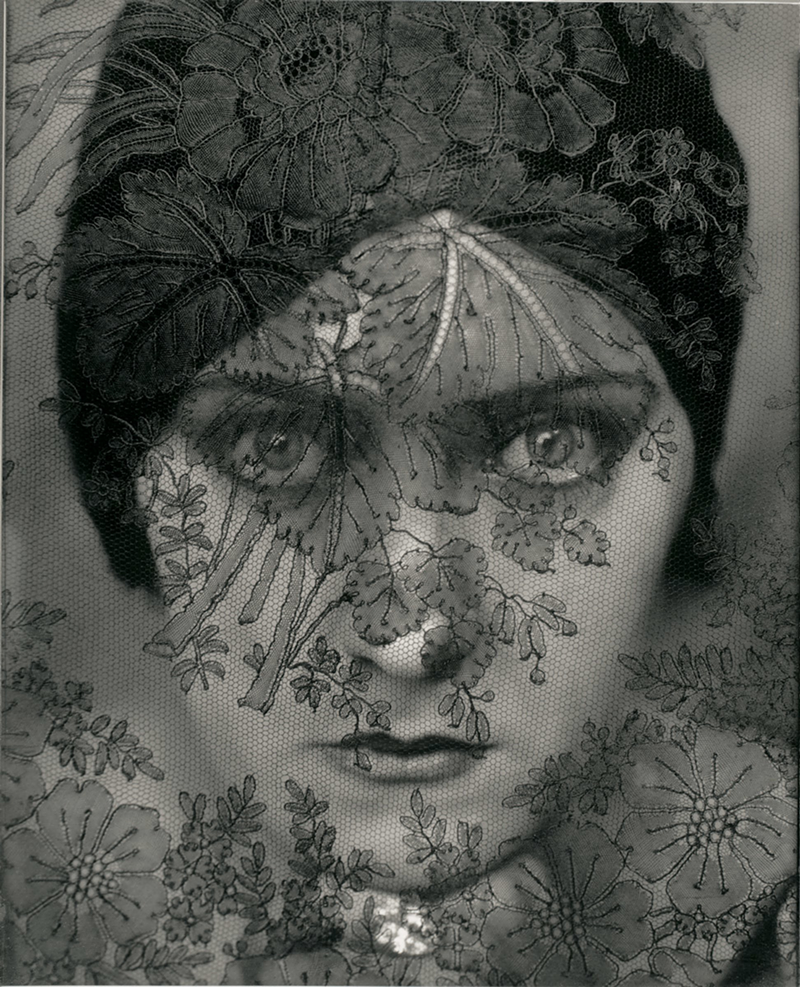Why are Hollywood glamour photographs on display at the Taft Museum of Art? FotoFocus isn’t reason enough; the Taft likes to establish a tie between the renowned permanent collection and temporary exhibitions. So what is Myrna Loy doing here?
If at first glance this one is a stretch, exhibition curator Nancy Huth is quick to remind that many of the celebrated portraits in the Taft holdings are meant to set their subjects apart from the general run of human beings, even as Steichen would do for the pages of Condé Nast magazines Vogue and Vanity Fair. Although Steichen’s long career had many elements, this exhibition centers on his representation of “Hollywood legends and cultural icons” and is called Star Power: Edward Steichen’s Glamour Photography for good reason. Stardom is not limited to Hollywood; writers, artists, stage performers and other significantly accomplished people sat before Steichen’s camera.
Clothes can benefit from glamour treatment as well. Two sections of the exhibition present photographs intended for the pages of Vogue. The first shows 1920s fashions, daring for their day, and the second more conservative 1930s outfits. Here, perhaps even more than in the portraiture, Steichen’s background in painting is evident. He had also studied lithography and had a comprehensive understanding of the half tone process. With these skills at work, the clothing in his photographs takes on the same glamour he imparted to his human sitters. Steichen’s tenure as chief photographer for Condé Nast would run from 1923-1938 and fashion photography as we now think of it was born then. Fashion modeling, for the first time, became a career choice.
Because this work was meant for the pages of a magazine, the inclusion of two open issues, side by side, is an informative addition to the framed prints on the walls. The interest here is differences in layout. The earlier, dated 1928, shows Gloria Swanson behind a lace veil; type areas have a distinctly old-fashioned, crowded look. Only one year later the layout has opened up, more white space appears, there’s more contrast in type face and type size and Greta Garbo is shown in what would become an iconic portrait of the star. Her hands, covered by sweater sleeves, push back her hair and cover her ears. It has an unplanned, this-very-moment sense, vastly different from the exotic but static Swanson portrait.
An old-fashioned view camera, the type Steichen would have been using, is also among the exhibition’s non-photograph elements and is displayed so that it’s possible to look through the back, as though you were the photographer, and see what’s in the view finder. Recognizing the ubiquity of camera phones today, this back corner of the exhibition also includes a small area fitted out for impromptu picture-taking by visitors to the show. Anyone may pull sweater sleeves over hands, push back hair, pose for a friend and see if she looks like Garbo. Or, if male, give a try to taking on the pose of a young Gary Cooper, hanging near by.
Steichen would go on to government work during the war and later became director of the Museum of Modern Art’s photography department at a time when many museums were still uncertain if photography were art.
That question has been settled for good, I think, and this show demonstrates the level of skill that tipped the balance from craftsman to artist. Steichen brought new ideas and inventive techniques to his employer’s sophisticated magazines and helped to change our ideas of how we aspire to look, even as some of the famous portraits in the Taft’s permanent collection did in their time. Nancy Huth, curator of education for the Taft, is curator for Star Power’s appearance here. This traveling exhibition was organized by the Foundation for the Exhibition of Photography; prints in the show are from Condé Nast archives, as are the working prints for the magazines.
Lynne Ambrosini, the Taft’s chief curator, has a tantalizing thought about the subjects of these 1920s/1930s photographs. Famous people were not unknown among the Taft’s guests during the 1920s. “All sorts of people came here,” she says. Perhaps, even, some of those whose portraits are in Star Power?
STAR POWER: EDWARD STEICHEN’S GLAMOUR PHOTOGRAPHY runs through Jan. 27 at the Taft Museum (taftmuseum.org).


